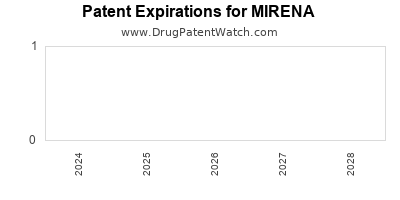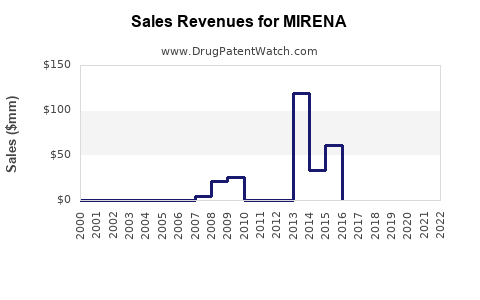MIRENA Drug Patent Profile
✉ Email this page to a colleague
Which patents cover Mirena, and what generic alternatives are available?
Mirena is a drug marketed by Bayer Hlthcare and is included in one NDA. There are two patents protecting this drug.
This drug has forty-five patent family members in twenty countries.
The generic ingredient in MIRENA is levonorgestrel. There are twenty drug master file entries for this compound. Thirty-four suppliers are listed for this compound. Additional details are available on the levonorgestrel profile page.
DrugPatentWatch® Litigation and Generic Entry Outlook for Mirena
A generic version of MIRENA was approved as levonorgestrel by NOVEL LABS INC on February 22nd, 2013.
AI Deep Research
Questions you can ask:
- What is the 5 year forecast for MIRENA?
- What are the global sales for MIRENA?
- What is Average Wholesale Price for MIRENA?
Summary for MIRENA
| International Patents: | 45 |
| US Patents: | 2 |
| Applicants: | 1 |
| NDAs: | 1 |
| Finished Product Suppliers / Packagers: | 1 |
| Raw Ingredient (Bulk) Api Vendors: | 112 |
| Clinical Trials: | 75 |
| Patent Applications: | 3,293 |
| Drug Prices: | Drug price information for MIRENA |
| What excipients (inactive ingredients) are in MIRENA? | MIRENA excipients list |
| DailyMed Link: | MIRENA at DailyMed |



Recent Clinical Trials for MIRENA
Identify potential brand extensions & 505(b)(2) entrants
| Sponsor | Phase |
|---|---|
| Bayer | PHASE3 |
| Peking University People's Hospital | PHASE2 |
| Benha University | NA |
Pharmacology for MIRENA
| Drug Class | Progestin Progestin-containing Intrauterine System |
| Physiological Effect | Inhibit Ovum Fertilization |
US Patents and Regulatory Information for MIRENA
MIRENA is protected by two US patents.
| Applicant | Tradename | Generic Name | Dosage | NDA | Approval Date | TE | Type | RLD | RS | Patent No. | Patent Expiration | Product | Substance | Delist Req. | Exclusivity Expiration |
|---|---|---|---|---|---|---|---|---|---|---|---|---|---|---|---|
| Bayer Hlthcare | MIRENA | levonorgestrel | SYSTEM;INTRAUTERINE | 021225-001 | Dec 6, 2000 | RX | Yes | Yes | 11,850,182 | ⤷ Get Started Free | Y | ⤷ Get Started Free | |||
| Bayer Hlthcare | MIRENA | levonorgestrel | SYSTEM;INTRAUTERINE | 021225-001 | Dec 6, 2000 | RX | Yes | Yes | 10,561,524 | ⤷ Get Started Free | ⤷ Get Started Free | ||||
| >Applicant | >Tradename | >Generic Name | >Dosage | >NDA | >Approval Date | >TE | >Type | >RLD | >RS | >Patent No. | >Patent Expiration | >Product | >Substance | >Delist Req. | >Exclusivity Expiration |
Expired US Patents for MIRENA
| Applicant | Tradename | Generic Name | Dosage | NDA | Approval Date | Patent No. | Patent Expiration |
|---|---|---|---|---|---|---|---|
| Bayer Hlthcare | MIRENA | levonorgestrel | SYSTEM;INTRAUTERINE | 021225-001 | Dec 6, 2000 | 5,785,053 | ⤷ Get Started Free |
| >Applicant | >Tradename | >Generic Name | >Dosage | >NDA | >Approval Date | >Patent No. | >Patent Expiration |
International Patents for MIRENA
See the table below for patents covering MIRENA around the world.
| Country | Patent Number | Title | Estimated Expiration |
|---|---|---|---|
| Japan | 5390618 | ⤷ Get Started Free | |
| Mexico | 2011002670 | UN INSERTADOR. (AN INSERTER.) | ⤷ Get Started Free |
| Japan | 2012502713 | ⤷ Get Started Free | |
| European Patent Office | 2352470 | ⤷ Get Started Free | |
| Israel | 211058 | ⤷ Get Started Free | |
| >Country | >Patent Number | >Title | >Estimated Expiration |
Supplementary Protection Certificates for MIRENA
| Patent Number | Supplementary Protection Certificate | SPC Country | SPC Expiration | SPC Description |
|---|---|---|---|---|
| 1453521 | C 2015 029 | Romania | ⤷ Get Started Free | PRODUCT NAME: LEVONORGESTREL SI ETINILESTRADIOL; NATIONAL AUTHORISATION NUMBER: RO 7793/2015/001; DATE OF NATIONAL AUTHORISATION: 20150612; NUMBER OF FIRST AUTHORISATION IN EUROPEAN ECONOMIC AREA (EEA): SK. 17/0017/15-S; DATE OF FIRST AUTHORISATION IN EEA: 20150129 |
| 1453521 | 300814 | Netherlands | ⤷ Get Started Free | PRODUCT NAME: LEVONORGESTREL EN ETHINYLESTRADIOL; NATIONAL REGISTRATION NO/DATE: RVG 117453 20151211; FIRST REGISTRATION: SK 17/0017/15-S 20150211 |
| 1453521 | 122015000093 | Germany | ⤷ Get Started Free | PRODUCT NAME: LEVONORGESTREL UND ETHINYLESTRADIOL; NAT. REGISTRATION NO/DATE: 87675.00.00 20150720; FIRST REGISTRATION: SLOWAKEI 17/0017/15-S 20150129 |
| 1453521 | 132016000025143 | Italy | ⤷ Get Started Free | PRODUCT NAME: LEVONORGESTREL ED ETINILESTRADIOLO(SEASONIQUE); AUTHORISATION NUMBER(S) AND DATE(S): 17/0017/15-S, 20150211;042139016, 20150414 |
| 1453521 | 39/2015 | Austria | ⤷ Get Started Free | PRODUCT NAME: ETHINYLESTRADIOL UND EINE KOMBINATION VON LEVONORGESTREL UND ETHINYLESTRADIOL; NAT. REGISTRATION NO/DATE: 136021 20150224; FIRST REGISTRATION: SK 17/0017/15-S 20150211 |
| >Patent Number | >Supplementary Protection Certificate | >SPC Country | >SPC Expiration | >SPC Description |
MIRENA Market Analysis and Financial Projection
More… ↓
Make Better Decisions: Try a trial or see plans & pricing
Drugs may be covered by multiple patents or regulatory protections. All trademarks and applicant names are the property of their respective owners or licensors. Although great care is taken in the proper and correct provision of this service, thinkBiotech LLC does not accept any responsibility for possible consequences of errors or omissions in the provided data. The data presented herein is for information purposes only. There is no warranty that the data contained herein is error free. We do not provide individual investment advice. This service is not registered with any financial regulatory agency. The information we publish is educational only and based on our opinions plus our models. By using DrugPatentWatch you acknowledge that we do not provide personalized recommendations or advice. thinkBiotech performs no independent verification of facts as provided by public sources nor are attempts made to provide legal or investing advice. Any reliance on data provided herein is done solely at the discretion of the user. Users of this service are advised to seek professional advice and independent confirmation before considering acting on any of the provided information. thinkBiotech LLC reserves the right to amend, extend or withdraw any part or all of the offered service without notice.
